|
More Info. & Photo's For
Cheesman Family
Payne County
Webb Family
Glenn Family
Burke Family
| |
|
Welcome to
My family web site
My name is Jan Ann Burke
(Weisenfels). My parents are, Charles
Leon Burke and Mary Lorene Hawley. This site retains history about
my Parents and Grand Parents the Burke, Webb, Glenn, & Cheesman Family's
from Cushing, Payne County Oklahoma.
Message
Board
Check out
my maternal web site at
http:members.tripod.com/briscoe_family
Surnames:
Baker, Abell, Kennedy, Shumate,
Frazell, Frizell, Burk, Burke, Webb, Cheesman, Cheeseman, Glen, Glenn,
Edwards, Fern, Caldwell, Kenoyer, Hunsaker, Rucker, Stout, Elam, and many more.
|
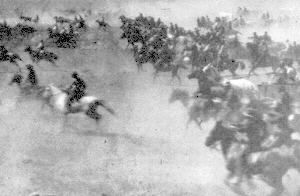
"The Cherokee Strip"
The 226-mile tract known as the Cherokee Strip is much more than a
parcel of land. It was the setting for the largest, most spectacular competitive
event in history -- the Cherokee Strip Land Run of 1893. Cities and towns grew
from the dust of that great race, and today their amazing story can still be
heard across the Oklahoma plains.
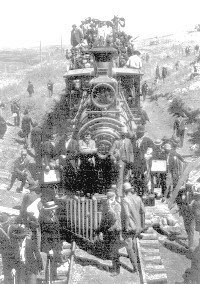
Oklahoma's Cherokee Strip is one of the few places where the pioneer spirit
that settled American is still vibrant enough to experience. Feel it in the wind
that sweeps through tall grass prairies and fields of wheat. See it in the faces
of those who live and work on the land their ancestors dreamed of owning when
they mounted their horses, buggies and even bicycles and trains, to make the
last great race for land on that hot and dusty afternoon of September 16, 1893.
This is a story of drama, perseverance, hope and above all, dreams.
The Land
The Cherokee Strip extends 226 miles from east to west and 58 miles north to
south -- larger than the states of Connecticut, Delaware and Rhode Island
combined. Thirteen northern counties and 9,400 miles make up Oklahoma's portion
of the Cherokee Strip, historically designated as the Cherokee Outlet. Looking
across the vast horizon of the Cherokee Strip, it's easy to imagine the
thousands of buffalo that once roamed the open plains. It is a land as diverse
as America itself, with rolling Osage prairies in the east to gypsum sand dunes
and the rugged Glass Mountains in the west.
American Indians In The Strip
Although the flags of many countries have flown symbolically over the untamed
lands of the Cherokee Strip, American Indians were its original owners. In 1828,
the U.S. government gave the land to the Cherokees, calling the area the
Cherokee Outlet because the tribe could cross freely to hunting grounds in the
west. The Cherokees were assigned lands in northeastern Oklahoma (then Indian
Territory), and never lived in the Cherokee Strip.
In 1866, the United States asked the Cherokees to sell portions of the Strip
to "friendly" Indians. Tribes or parts of tribes, such as Osage,
Pawnee, Kaw, Ponca, Tonkawa, Nez Perce, Otoe and Missouria, settled in the
region. When the Strip was opened to white settlement, tribes living there --
with the exception of the Nez Perce, who were previously moved to their Oregon
homeland -- were sold individual allotments not to exceed 80 acres, half of the
allotment amount offered to settlers who made the run. Museums and attractions
throughout the Cherokee Strip tell the poignant story of American Indians and
how their cultures and spirituality have persevered during the last 100 years.
The Cattle Trails
After the Civil War, Texas had some six million head of longhorn cattle but
virtually no market for the beef. Demand for their product by hungry Easterners
led Texas ranchers to drive their cattle through the Cherokee Strip to railhead
markets in Kansas and Missouri. Several cattle trails crossed the Outlet, but
the best known is the namesake of Jesse Chisholm, a Scotch and Cherokee trader.
Chisholm made his first trip up the trail in 1865, and millions of cattle
thundered across the Strip over the next 20 years, driven by men who had spurred
a new occupation -- the cowboy. Remnants of the famous Chisholm Trail can still
be found across the Cherokee Strip. In 1993, at the commemoration of the
Centennial Anniversary of the opening of the Strip, this colorful era returned
when many people participated in cattle drives, wagon trains and trail rides
that made their way through the region.
The Great Ranches
When it became obvious raising cattle on the lush grass of the Outlet was
more profitable than driving herds from Texas, sprawling ranches appeared in the
Strip. In 1883 the Cherokee Strip Livestock Association was formed and six
million acres were leased from the Cherokees. Seven years later, President
Benjamin Harrison ordered the ranchers to remove all cattle from the Strip.
Plans were in place to open the expansive ranchlands for settlement by eager
pioneers.
The Race
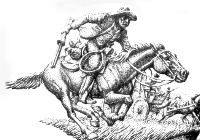 They came to the land that would be Oklahoma by train, horseback, wagon and on
foot, from every state and territory in the nation and abroad. Texas and Kansas
had the most settlers represented. Most had few material possessions but all
came with a dream: to stake a claim and make a home on the vast, virgin prairie
known as the Cherokee Strip.
They came to the land that would be Oklahoma by train, horseback, wagon and on
foot, from every state and territory in the nation and abroad. Texas and Kansas
had the most settlers represented. Most had few material possessions but all
came with a dream: to stake a claim and make a home on the vast, virgin prairie
known as the Cherokee Strip.
President Cleveland and Secretary of Interior H. R. Smith hoped they learned
something from earlier "stampedes" for land. They hoped that with
better planning they could avoid the troubles and confusion that accompanied the
1889 land rush. Prior to opening the land they established county seats and
opened four land offices at Enid, Perry, Alva and Woodward. Homesteaders were to
go to these offices and pay a filing fee ranging from $1.00 to $2.50. Filing
fees were based upon the quality of land. However, the Strip was to be settled
by the horse-race method. To eliminate "sooners," they set up
makeshift offices just inside the Cherokee Strip border. Homesteaders were to
register and produce filing fee affidavits to be eligible for the run.
On the day of the run, it was hot and dry. Dust, whipped by wind, and
thousands of feet, made it unbearable. To add to the misery, soldiers were doing
their best to keep order, and see that no one "jumped the gun." The
run was to begin only when troopers shot their pistols at high noon. There were
several reports of persons shooting a gun in the crowd. Many homesteaders
excitedly took off on hearing any gun shot. Such excitement could only lead to
trouble for some. One fellow heard the wild shot at four minutes before noon,
and took off. Troopers reportedly chased him for a quarter mile before shooting
him dead.
Finally, at noon September 16, 1893, a shot rang out and more than 100,000
determined settlers raced for 42,000 claims. By sunset, there would be tent
cities, endless lines at federal land offices and more losers than winners. The
Cherokee Strip Land Run was a tumultuous finale to what many have called the
last American frontier.
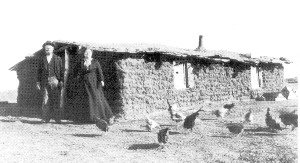 Making the race and staking a claim must have seemed simple when compared to
establishing a home in the sometimes formidable Cherokee Strip. Many settlers
carved sod homes and dugouts from the prairie while others lived in their
covered wagons. The first winters were harsh as the land tested the endurance
and character of its new inhabitants. Many of the settlers could not endure the
harsh conditions, and after weeks, or months, gave up their dream.
Making the race and staking a claim must have seemed simple when compared to
establishing a home in the sometimes formidable Cherokee Strip. Many settlers
carved sod homes and dugouts from the prairie while others lived in their
covered wagons. The first winters were harsh as the land tested the endurance
and character of its new inhabitants. Many of the settlers could not endure the
harsh conditions, and after weeks, or months, gave up their dream.
The hard times gave way to better days as crops flourished and communities,
schools and churches rose from the windswept plains. Over 100 years later,
agriculture remains the strength of the economy and way of life. The stories of
these brave homesteaders still echo through the Cherokee Strip. Walk through the
only remaining sod house, explore the many Cherokee Strip Museums, or visit with
people whose ancestors, through grit and determination, settled this untamed
frontier.
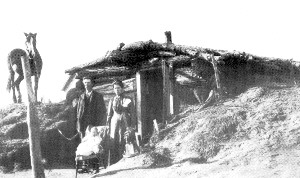
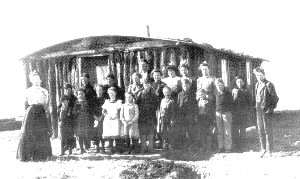
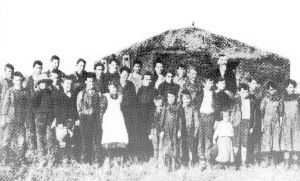
 |
|
 |
email me @
jaweisenfels@cox-internet.com

|



